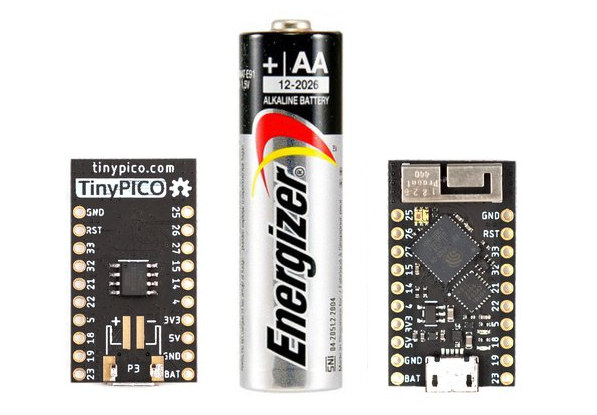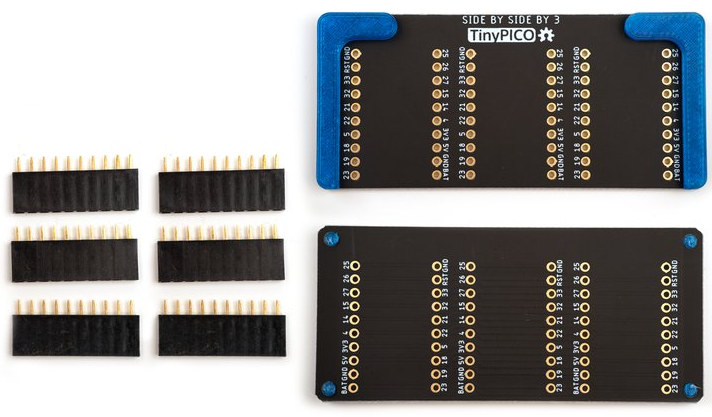There are so many ESP32 boards available now, so why bother with another ones. Some of the key selling points of TinyPICO are that it is really small at 32 x 18 mm, it’s easy to use out of the box with MicroPython firmware pre-loaded, and supports LiPo batteries with an optimized power path for low-power battery usage.
The developer, named Unexpected Maker, also provides various shields for TinyPICO adding a display, sensors, an audio amplifier, an RTC, Grove headers, and more.
 TinyPICO board specifications:
TinyPICO board specifications:
- System-in-Package – Espressif Systems ESP32-PICO-D4 SiP with ESP32 dual-core processor operating at 240 MHz, 4 MB SPI flash
- External System Memory – 4 MB PSRAM
- Connectivity – 2.4 GHz WiFi 4 802.11b/g/n, Bluetooth 4.2 LE, 3D antenna
- Expansion – 14x GPIO broken out to standard pitch headers
- Debugging / Programming – USB + serial/UART for programming
- Misc – Power (red) & charge (orange) LED’s, APA102 RGB LED
- Power Supply
- 5V via micro USB port
- 700 mA 3.3 V LDO regulator
- Optimized power path for low-power battery usage
- LiPo battery management
- Battery pads on the bottom support both JST PH & MicroBlade connectors (included unassembled with every TinyPICO)
- Power Consumption – Deep sleep: 18 uA
- Dimensions – 32 x 18 mm (Breadboard-friendly)
While the board comes with MicroPython pre-installed, it also supports the Arduino IDE and Espressif IDF like other ESP32 boards, as well as plenty of example code and libraries.
Five shields have been designed for TinyPICO board so far:
- Play Shield with a 128×64 white OLED display, 3-axis accelerometer, light sensor, mono amplifier, magnetic buzzer, blue LED, 4x input buttons + reset button, and a LiPo connector with power switch
- Audio Shield with a 1.5 W mono amplifier, a magnetic buzzer, a trimmer potentiometer for gain control, and s switch to swap between on-board buzzer and external speakers
- RTC Shield with MCP7940N RTC chip and a battery holder for one CR1025 battery
- Grove I²C Shield with three I²C headers compatible with Seeed Studio Grove modules
- Proto Shield with a prototyping area to solver components and three buttons (reset + 2x user buttons)
 The “3 Up Shield” board enables you to connect a TinyPICO and up to 2 shields without having to stack the boards vertically.
The “3 Up Shield” board enables you to connect a TinyPICO and up to 2 shields without having to stack the boards vertically.
The project will be open source with all hardware released under the CERN open hardware license, all software under the MIT open software license, and you’ll find both in TinyPICO GitHub account.
TinyPICO launched on Crowd Supply a few days, and the campaign is going well so far with over $11,000 raised from close to 160 backers. Pledges start at $26 for TinyPICO board with unassembled male headers, stackable headers, a JST PH battery connector, and a JST MicroBlade battery connector. There are bundles with multiple boards, and some with shields, but if you want to have a bit more fun, TinyPICO Shield Pack adds the last four shields listed above (Audio, RTC, Grove, Proto), plus the 3 Up Shield to the basic reward in a bundle that goes for $55. Shipping is free to the US, $9 to the rest of the world, and backers should expect their toy(s) to be shipped by the end of July 2019.
Thanks to Alexis for the tip.

Jean-Luc started CNX Software in 2010 as a part-time endeavor, before quitting his job as a software engineering manager, and starting to write daily news, and reviews full time later in 2011.
Support CNX Software! Donate via cryptocurrencies, become a Patron on Patreon, or purchase goods on Amazon or Aliexpress





